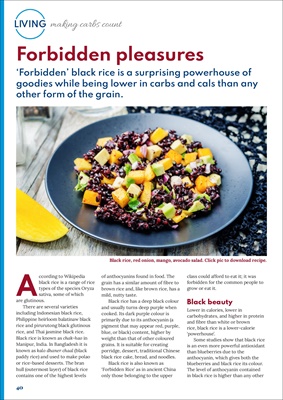
40
LIVING making carbs count
Forbidden pleasures
'Forbidden' black rice is a surprising powerhouse of
goodies while being lower in carbs and cals than any
other form of the grain.
According to Wikipedia
black rice is a range of rice
types of the species Oryza
sativa, some of which
are glutinous.
There are several varieties
including Indonesian black rice,
Philippine heirloom balatinaw black
rice and pirurutong black glutinous
rice, and Thai jasmine black rice.
Black rice is known as chak-hao in
Manipur, India. In Bangladesh it is
known as kalo dhaner chaal (black
paddy rice) and used to make polao
or rice-based desserts. The bran
hull (outermost layer) of black rice
contains one of the highest levels
of anthocyanins found in food. The
grain has a similar amount of fibre to
brown rice and, like brown rice, has a
mild, nutty taste.
Black rice has a deep black colour
and usually turns deep purple when
cooked. Its dark purple colour is
primarily due to its anthocyanin (a
pigment that may appear red, purple,
blue, or black) content, higher by
weight than that of other coloured
grains. It is suitable for creating
porridge, dessert, traditional Chinese
black rice cake, bread, and noodles.
Black rice is also known as
'Forbidden Rice' as in ancient China
only those belonging to the upper
class could afford to eat it; it was
forbidden for the common people to
grow or eat it.
Black beauty
Lower in calories, lower in
carbohydrates, and higher in protein
and fibre than white or brown
rice, black rice is a lower-calorie
'powerhouse'.
Some studies show that black rice
is an even more powerful antioxidant
than blueberries due to the
anthocyanin, which gives both the
blueberries and black rice its colour.
The level of anthocyanin contained
in black rice is higher than any other
Black rice, red onion, mango, avocado salad.